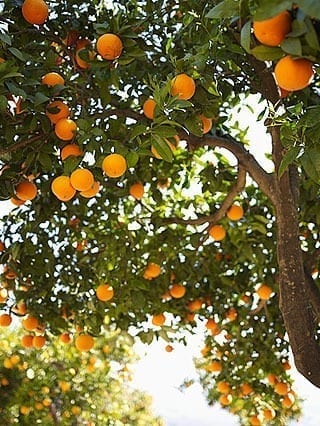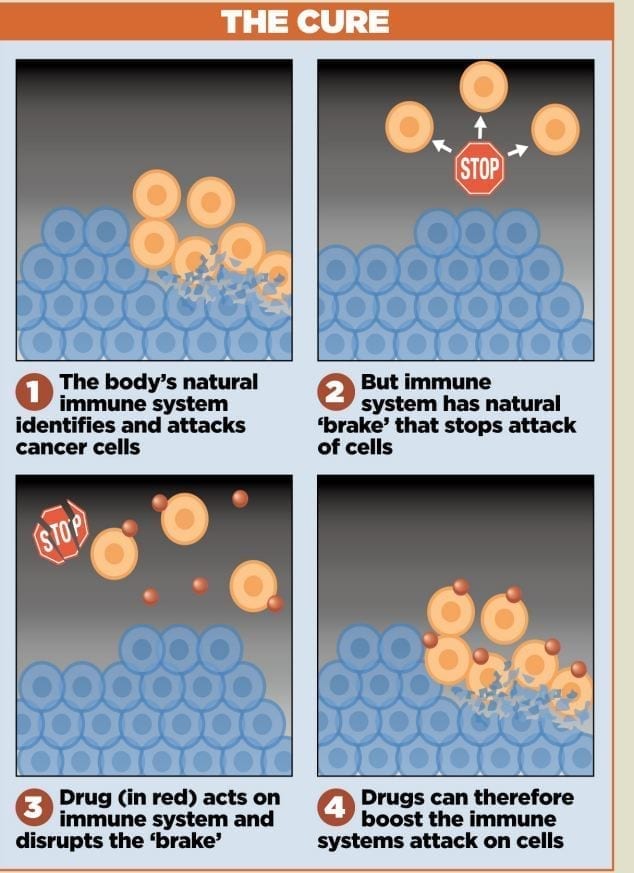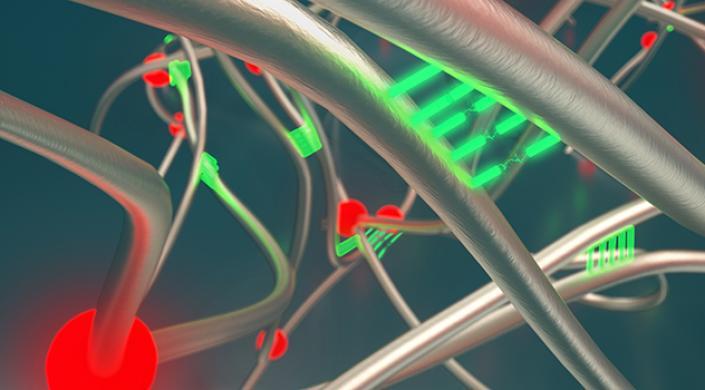
The devastating disease Huonglongbing, or citrus greening, looms darkly over the United States, threatening to wipe out the nation’s citrus industry, whose fresh fruit alone was valued at more than $3.4 billion in 2012.
Recently, however, a research team led by a University of California, Davis, plant scientist used DNA sequencing technologies to paint a broad picture of how citrus greening impacts trees before they even show signs of infection, offering hope for developing diagnostic tests and treatments for the currently incurable disease.
“Florida is seemingly in the death grip of citrus greening, and many experts believe it is just a matter of time before the disease appears full force in California,” said plant molecular biologist Abhaya Dandekar, lead author on the study.
The new findings indicate that the bacterial disease interferes with starch and sugar metabolism in young and mature leaves and fruit, while also wreaking havoc with hormonal networks that are key to the trees’ ability to fend off infections. Study results will be reported Sept. 25 in the journal PLOS ONE.
“Because the disease has a long latent phase during which there are no symptoms of infection and the bacteria are resistant to being grown in the laboratory, the only option for halting transmission of citrus greening has been to apply chemical pesticides to control the insect that spreads the bacteria,” Dandekar said.
About citrus greening
HLB, or citrus greening, is the most destructive citrus disease worldwide. It is caused by three species of the Candidatus Liberibacter bacteria, including Candidatus Liberibacter asiaticus, which is known by the abbreviation CaLas. These bacteria are carried from tree to tree by two species of the citrus psyllid, a winged insect that is about one-eighth of an inch long and attaches itself to the underside of the trees’ leaves.
As the citrus psyllid feeds on a leaf, it can pick up the bacteria from a diseased tree and introduce the bacteria to a non-infected tree. These disease-causing bacteria reside in the tree’s phloem — the vascular tissue that carries vital nutrients throughout the tree.
The disease affects most citrus species, causing yellowing of shoots, blotchy and mottled leaves, lopsided and poorly colored fruit and loss of viable seeds. The fruit of diseased trees is hard, misshapen and bitter, and the infected trees die within a few years.
Other than one infected backyard tree found in 2012 in the Southern California community of Hacienda Heights, the disease has not been detected in California. However the citrus psyllid that transmits the bacteria was first found in California in 2008 and has since been identified in San Diego, Imperial, Riverside, San Bernardino, Orange, Los Angeles, Ventura, Santa Barbara, Kern and Tulare counties, resulting in quarantines and restricted areas.
The new study
In this new study, the researchers studied four categories of healthy and diseased citrus trees, with the goal of better understanding how HLB affects trees physiologically during the very early stages of infection.
“Earlier sequencing of the CaLas bacteria genome showed that there were no toxins or enzymes that would destroy plant cell walls, or specialized secretion systems associated with citrus HLB,” Dandekar said.
“Because these factors, which normally accompany plant diseases, were not present, we suspected that the disease was causing metabolic imbalances or interfering with nutrient transport in the infected trees,” he said.
The researchers used gene sequencing technology to study the “transcriptome,” which is the collection of RNA found in the tree leaves and fruit.
Their analysis confirmed that in infected trees, HLB disease caused starch to accumulate in the leaves, blocking nutrient transport through the phloem and decreasing photosynthesis. They also found that normal metabolism of sucrose, a sugar also key to photosynthesis, was disrupted.
Furthermore, the researchers discovered that HLB interfered with the regulation of hormones such as salicylic acid, jasmonic acid and ethylene, which are “the backbone” of the plant innate immune response. And they found that infected trees also had changes in the metabolism of important amino acids that serve as a reservoir for organic nitrogen in many plants. The nitrogen is required to stimulate the plant immune response.
Cause for hope
The researchers anticipate that these discoveries will lead the way to new tests for detecting the bacteria and thus the presence of HLB in orchard trees.
They also suggest that it may be possible to develop several short-term treatments for infected trees. Such therapeutic procedures might rely on using hormones and other small molecules to restore the infected tree’s normal metabolism or boosting the tree’s innate immune response to effectively fight the infection.
The Latest Bing News on:
Citrus greening
- Farm Bill proposal concentrates on HLB fundingon May 9, 2024 at 2:00 pm
California Citrus Mutual praises congressional leaders for prioritizing funding to combat citrus disease Huanglongbing in 2024 Farm Bill ...
- Florida Citrus ‘Box’ Taxes To Go Unchangedon May 9, 2024 at 10:52 am
The Florida Citrus Commission on Thursday did not propose increasing “box” taxes charged to citrus growers as the panel began setting a budget for the next fiscal year. Shannon Shepp, executive ...
- Tourists to continue getting taste of Florida orange juiceon May 9, 2024 at 10:00 am
The promotional efforts come as the industry continues struggling with issues such as deadly citrus-greening disease and fallout from Hurricane Ian, which plowed through citrus-growing areas in 2022.
- Free orange juice will continue to flow at Florida's welcome centerson May 9, 2024 at 5:15 am
The Florida Citrus Commission on Thursday will be asked to approve a $225,000 contract with Visit Florida about the welcome center refreshment, a reduction of $25,000 from the past ...
- Free orange juice will stay at Florida welcome centers, despite budget sliceon May 8, 2024 at 11:10 am
Free orange juice will continue to flow at Florida interstate welcome centers while state citrus officials adjust to a pending 10% legislative budget cut for promotions.
- Higher citrus volumes from Southern Hemisphere expected in the USon May 8, 2024 at 6:47 am
The latest report from the USDA shows that between January and February of this year, citrus imports to the U.S. were up 34 million pounds YOY ...
- Market Struggles Squeezing Out Some Florida Citrus Associationson May 8, 2024 at 5:57 am
Constant headwinds of HLB are taking a toll on Florida's regional citrus associations. One just announced its closing. This is the second in as many months.
- Alico May Need Multiple Seasons for Production to Recover From Hurricane Ian -- Commodity Commenton May 6, 2024 at 4:22 pm
By Adam L. Cataldo Alico said it will take one, and possibly more, seasons for its orange production to reach the levels seen prior to Hurricane Ian.
- Can Growing Citrus Under Protective Screen Save Florida’s Signature Crop?on May 2, 2024 at 12:07 pm
A main factor that drew Callaham into the CUPS world is having a sustainable way to grow more with less. “We are using substantially less land, water, and fertilizer to produce each piece of fruit ...
- Florida citrus hopes for 2024 reboundon April 29, 2024 at 4:05 am
The Florida citrus industry has battled continued difficulties in recent years. Citrus greening disease and weather events dropped last year’s production to historic levels.
The Latest Google Headlines on:
Citrus greening
[google_news title=”” keyword=”citrus greening” num_posts=”10″ blurb_length=”0″ show_thumb=”left”]
The Latest Bing News on:
Huonglongbing
- Farm Bill proposal concentrates on HLB fundingon May 9, 2024 at 2:00 pm
California Citrus Mutual praises congressional leaders for prioritizing funding to combat citrus disease Huanglongbing in 2024 Farm Bill ...
- Far From Home, the Curry Leaf Tree Thriveson May 8, 2024 at 12:10 pm
Native to tropical Asia and South Asia, the curry leaf tree has managed to adapt to our climate and withstand pests, producing fresh leaves for diaspora cooks and others who love their potent flavor.
- Farm Bill Frameworks Receiving Significant Industry Supporton May 3, 2024 at 9:19 am
Industry groups are rallying behind the newly proposed farm bill frameworks from the U.S. Senate and House Agriculture ...
- Science newson April 27, 2024 at 3:38 am
Reliably monitoring the amount of lithium (Li) present in rechargeable batteries, specifically in the so-called cathode active material (CAM), is key to understanding the condition of batteries ...
- Science newson April 27, 2024 at 12:27 am
A collaborative research team from NIMS and Tokyo University of Science has successfully developed an artificial intelligence (AI) device that executes brain-like information processing through ...
- Asian citrus psyllid spreading devastating disease to citrus treeson April 22, 2024 at 11:01 am
The Asian citrus psyllid is a sap-sucking bug that can spread a devastating disease to citrus trees. If the Asian citrus psyllid were to get on a healthy citrus tree, it could kill it in no time.
- Miracle cure or wishful thinking? Proposed treatment for citrus greening gets mixed reviews from growerson April 17, 2024 at 3:39 am
But in the mid-2000s, a blight swept over the state. Huanglongbing, more commonly known as citrus greening, is a bacterial disease that infects citrus trees. It’s spread by an insect called the ...
- Plant This Sweet Flower Under Your Citrus Trees And Say Goodbye To Pestson March 23, 2024 at 1:01 pm
Not only do these insects cause damage to the trees and fruit, but even worse, they can spread diseases like citrus canker and Huanglongbing (sometimes known as citrus greening). In particular, the ...
- The Citrus Family Treeon June 1, 2023 at 11:29 am
A bacterial disease called huanglongbing (a.k.a. citrus greening) that causes plants to defoliate, decay, and eventually die, is threatening commercial production on every arable continent ...
- Jenni Nanceon March 2, 2023 at 1:31 am
Jenni's book project, Yellow Dragon, is a Florida historical fiction centered around huanglongbing (HLB), also known as the citrus "greening" disease.
The Latest Google Headlines on:
Huonglongbing
[google_news title=”” keyword=”Huonglongbing” num_posts=”10″ blurb_length=”0″ show_thumb=”left”]










